Aerial combat was a prime feature of US major warfare throughout the 20th century. From 1918, when a US airman scored the first aerial victory, through 1999, US airmen shot down some 17,500 enemy airplanes. These included 624 in World War I, 15,800 in World War II, 894 in Korea, and 137 in Vietnam.
The 1990s wars against Iraq and Serbia were smaller, but US pilots still shot down 48 aircraft—39 Iraqi and nine Serbian aircraft.
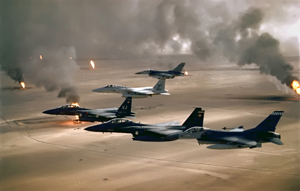
| ||
|
In 1991, USAF fighter aircraft pass oil fires, set by the Iraqi Army in retreating from Kuwait during Operation Desert Storm. USAF fighters downed 37 enemy fighters, with no losses, in that war. (USAF photo) |
At the turn of the century, however, air-to-air combat vanished. The US since 2000 has waged two major wars, one in Iraq and one in Afghanistan, but no pilot became an ace. Indeed, no one notched even a single aerial victory credit.
Airpower played significant roles in both of these recent wars, but fighting for air superiority was not one of them. There were no air battles at all.
The total absence of aerial combat so far in the 21st century has led some to claim that its day is gone forever, that expensive air superiority fighters and highly trained pilots are no longer necessary. This view is almost certainly wrong.
Why has air combat not played a role in the wars in Afghanistan or Iraq? The answer: Those wars were aberrations. War in the future probably will once again require the US to fight for air dominance—and not enjoy it from the beginning.
The first aberration occurred in Afghanistan.
On Oct. 7, 2001, Washington launched Operation Enduring Freedom against the Taliban regime of Afghanistan, the protector of Osama bin Laden and his al Qaeda terror organization. It was a mismatch in the air. The Afghan Air Force was so small that it did not even merit an entry in the annual Jane’s All the World’s Aircraft for the years 1999 to 2002.
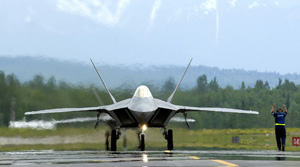 | ||
|
A crew chief marshals an F-22 during an exercise in Alaska. The absence of recent air combat has led some to wonder if such manned fighters are still necessary. (USAF photo by SrA. Garrett Hothan) |
Without its own aviation industry, Afghanistan had long depended on other nations, particularly the Soviet Union, for its aircraft. During the 1980s, as Moscow warred against the Afghan people, guerilla fighters became adept at using small surface-to-air missiles against airplanes.
A Plinking Campaign
During the 1990s, the emphasis within Afghanistan was on land combat between various local entities, of which the Taliban was one. What was left of the old Afghan Air Force was divided among the factions vying for control of the country. Spare parts to keep aircraft functioning were in short supply, and flying training was extremely limited.
By 1996, Taliban fighters had conquered all but the far north of the country, but their share of the surviving Afghan Air Force was small and weak. One estimate put the Taliban air force at eight MiG-21s, eight Su-22s, several transports, and about 12 helicopters.
Whatever the true numbers—and the estimates varied wildly—many were simply out of service, and only a handful of pilots remained.
US military planners never once worried about the Afghan aviation arm as aerial opposition. Indeed, the Afghan threat was far less than what US pilots faced every day enforcing the “no-fly” zones over Iraq.
However, those officers planning the Afghan war did have some concern the Taliban might pack aircraft with explosives and fly suicide missions into US military encampments. Thus, when the US struck Afghanistan, its military leaders were determined from the outset to establish uncontested control of the air.

| ||
|
Then-Col. Gary North runs a preflight check in an F-16 in 1999. The green star represents an Iraqi MiG-25 he shot down in 1992 during Operation Southern Watch. USAF’s enforcement of the two no-fly zones restricted Iraqi Air Force operations. (DOD photo) |
Among the 31 targets hit on the first night of the air war were Taliban airfields and aircraft. Air bases known to be harboring MiG-21 and Su-22 airplanes were Shindand AB and Mukurin AB. They were put out of commission.
Afghan air defenses were largely destroyed on that first night. Even so, for seven consecutive days after the first night, US airmen took part in an “aircraft plinking” campaign, the goal of which was to destroy, finally and to a certainty, every last enemy military aircraft and helicopter in Afghanistan.
The Pentagon did not officially announce the death of the Taliban air force until Oct. 25. In reality, the Afghan air arm had ceased to exist weeks earlier.
No Taliban aircraft got airborne to contest the coalition onslaught. In fact, no Taliban aircraft got airborne at any time in the entire campaign. US pilots had no opportunity to shoot down enemy airplanes. The Taliban had few to begin with. What few they did have were crushed within hours, even minutes.
Destruction of what little existed of the Taliban air defenses was so complete the United States was able to employ, at a very early stage in the campaign, slow-moving and low-flying helicopters, transports, gunships, and remotely piloted vehicles. These aircraft would have been too vulnerable to use in this fashion had the enemy possessed or retained an air force of even minimal effectiveness.
The second aberration came 17 months later, in Iraq.
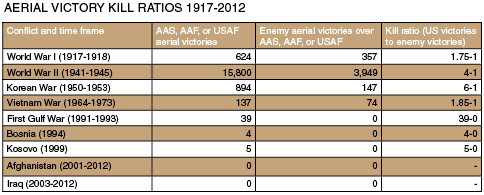
| ||
|
Air Force kill ratios have varied widely in various wars. Since the difficulty experienced in the Vietnam War, however, USAF has racked up 48 aerial victories with no losses. |
President Bush launched a war to topple the despotic and dangerous regime of Saddam Hussein, who had for years threatened his neighbors and who had defied United Nations inspectors seeking evidence of the manufacture of weapons of mass destruction.
Pilots of USAF aircraft entering Iraqi airspace at the opening of Operation Iraqi Freedom on March 19, 2003, could not be sure the Iraqi Air Force would be as impotent as the Afghan Air Force had been. After all, 12 years earlier, the Iraqi Air Force had been one of the most powerful in the entire region.
Iraq’s air arm had fought well during the brutal 1980-88 Iran-Iraq War. Early in the decade of the 1990s it was one of the largest air forces in Southwest Asia, with well over 700 fixed wing combat aircraft. Iraq had purchased new and capable fighter aircraft, including MiG-29s from the Soviet Union and Mirage F1s from France. Baghdad had improved its air bases, increasing the size and number of runways and taxiways and constructing hundreds of hardened aircraft shelters.
That rather formidable Iraqi Air Force, however, ran into a buzzsaw. It was called the United States Air Force.
In Operation Desert Storm—the Gulf War that unfolded between Jan. 17 and Feb. 28, 1991—USAF pilots shot down 37 Iraqi aircraft—32 airplanes and five helicopters. USAF and coalition aircraft also destroyed 254 additional Iraqi aircraft on the ground. Aircraft such as F-111s and F-117s, armed with laser and television guided bombs, destroyed 141 Iraqi aircraft in their shelters and another 113 in the open.
Counting airplanes that were flown in desperation to Iran, Baghdad lost 407 fixed wing airplanes—more than half its prewar force.
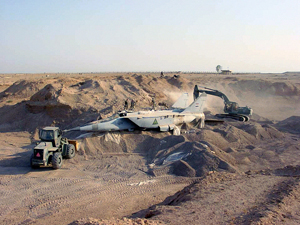
| ||
|
American military personnel unearth an Iraqi MiG-25 in 2003 at Al Taqqadum AB near Baghdad during Operation Iraqi Freedom. The Iraqi military buried several fighter aircraft to prevent their destruction by coalition forces. (DOD photo) |
The effect was devastating and long-lasting. The once-powerful Iraqi air arm went into a long disintegration as a true fighting force—a fact that became only too apparent 12 years later.
In the 2003 war, not one Iraqi warplane attacked the US and coalition forces advancing on the ground toward Baghdad. Complete aerial supremacy contributed to the quick victory that toppled the regime of Saddam and placed US and coalition military forces in the enemy capital in less than one month.
Desert Strike
Even earlier, during the 1990s, the US was aware of the drastically weakened condition of the Iraqi Air Force. During those years, the US and its coalition partners enforced no-fly zones over northern and southern Iraq.
Saddam rarely launched aircraft to challenge United States aircraft patrolling the UN-sanctioned no-fly zones over Iraq. Some cases, however, did arise.
At the end of 1992 and beginning of 1993, American F-16 pilots using advanced medium-range air-to-air missiles shot down two more Iraqi airplanes when they mounted challenges.
In 1996, Iraqi troops advanced under the northern no-fly zone and seized the Kurdish city of Irbil. In response, the US opened Operation Desert Strike. During that operation, USAF B-52s launched 13 cruise missiles against Iraqi military targets, including air defense and radar installations.
Another result of the Iraqi offensive in the northern no-fly zone was the extension of the southern no-fly zone northward from 32 degrees north to 33 degrees north latitude. This further restricted the space where the Iraqi Air Force could operate or train.
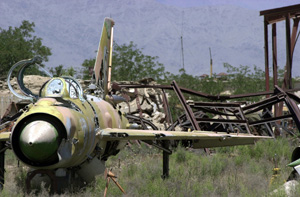
| ||
|
The remains of a MiG-21 decay in a field near Bagram Airfield, Afghanistan. In planning for Operation Enduring Freedom, USAF didn’t have to worry about the threat from the Afghan aviation arm. (DOD photo) |
Iraqi flights were restricted also by another factor. During the late 1980s, Saddam had sent 19 of his Soviet-made combat aircraft to Yugoslavia for refurbishing but was not able to get them back because of United Nations imposed economic sanctions on Iraq after its invasion of Kuwait. In September 1995, the UN Security Council had voted to extend sanctions against Iraq that had been in place for five years. As a result, worn-out Iraqi airplane parts could not be easily replaced, resulting in fewer operational warplanes.
Fearing attempted coups, the Iraqi dictator periodically purged his military leadership, including some of the high-ranking officers in the Iraqi Air Force. Saddam wanted Iraq’s military to be led by those unquestionably loyal to him. As a result, the Iraqi Air Force lacked the leadership it needed to revive itself.
Saddam’s refusal in late 1998 to allow UN inspectors to continue their work in Iraq prompted another set of US and allied air attacks on Iraq. During Operation Desert Fox, the United States and Britain bombed Tallil Air Base and destroyed several Iraqi remotely piloted aircraft that had been converted from trainers, presumably to deliver chemical or biological weapons.
All of these factors further weakened the tattered remnant of the Iraqi Air Force that had survived the Gulf War. And that remnant wasn’t much; in 2002, the Iraqi inventory totaled 267 aircraft, only 124 of them fighters, some small fraction of which were even combat-ready.
The Most Expensive
When the United States invaded Iraq in 2003, the Iraqi Air Force did not show up. It failed to generate a single sortie. Allied air and ground forces operated without any opposition in the air.
This striking absence of Iraqi Air Force opposition allowed the US Air Force to use its relatively vulnerable aircraft—A-10s and AC-130 gunships, for instance—without much fear they would be shot down.

| ||
|
An aerial view of an Iraqi field in 2005 shows derelict MiG-27s and a MiG-25. In Iraqi Freedom, no Iraqi warplanes attacked coalition forces advancing to Baghdad. (DOD photo) |
In the years since the start of the Afghan and Iraq wars, technological advances have made it possible for remotely piloted aircraft to detect and destroy enemy forces on the ground, even if those targets are moving. Pilots on the ground in Nevada have performed air strikes against enemy targets on the other side of the world in Afghanistan and Iraq.
These capabilities tempt some to believe manned fighters are no longer necessary.
However, remotely piloted aircraft are relatively slow and easy to shoot down. They are no match for faster, better armed, and more durable manned fighters that would be more likely to shoot them down than the other way around.
Future wars might well involve opponents with much more powerful air forces than those of Afghanistan and Iraq. Former enemies such as China and Russia, for example, are currently developing fifth generation fighter aircraft with stealth technology.
Air forces with such technology might challenge US control of the skies over battlefields. The skies themselves would be battlefields, with fighter aircraft clashing for control of the air.
If the enemy ever gained air superiority, the dynamic of combat would change immediately. Control of the air is the sine qua non of victory in modern warfare. A powerful enemy fighter force, if not countered by a powerful US fighter force, would destroy other allied aircraft such as transports, helicopters, ISR aircraft, and remotely piloted aircraft.
In terms of national policy objectives, modern fighter aircraft are extremely expensive. The lack of modern fighter aircraft, when war comes, would be even more expensive.